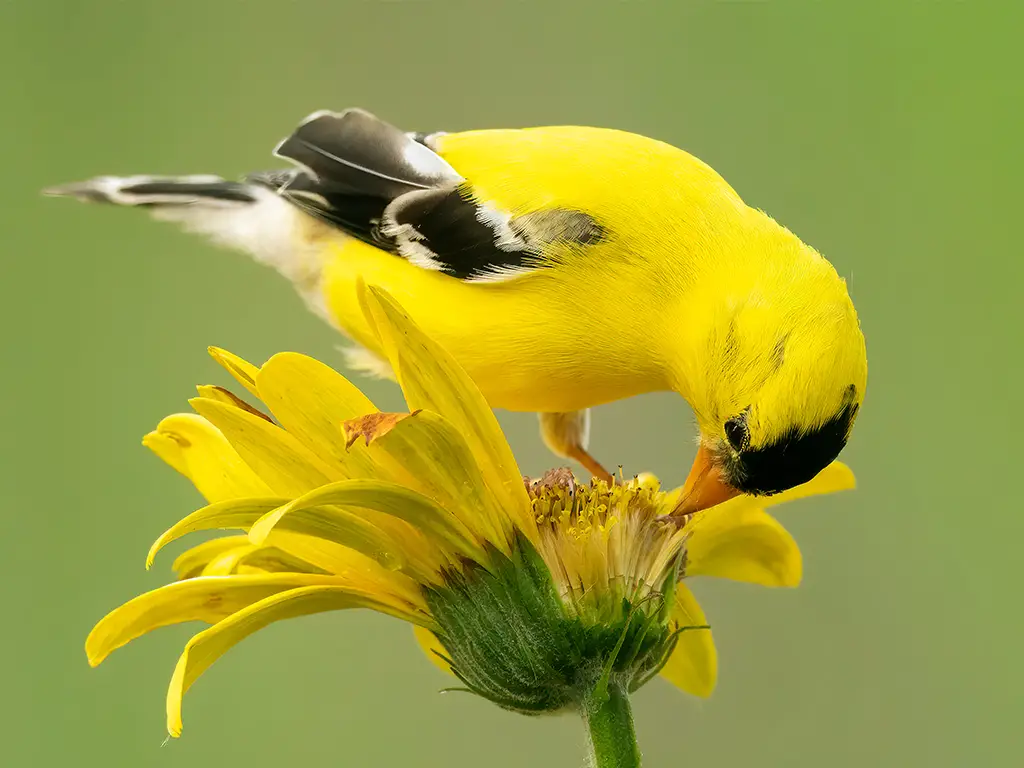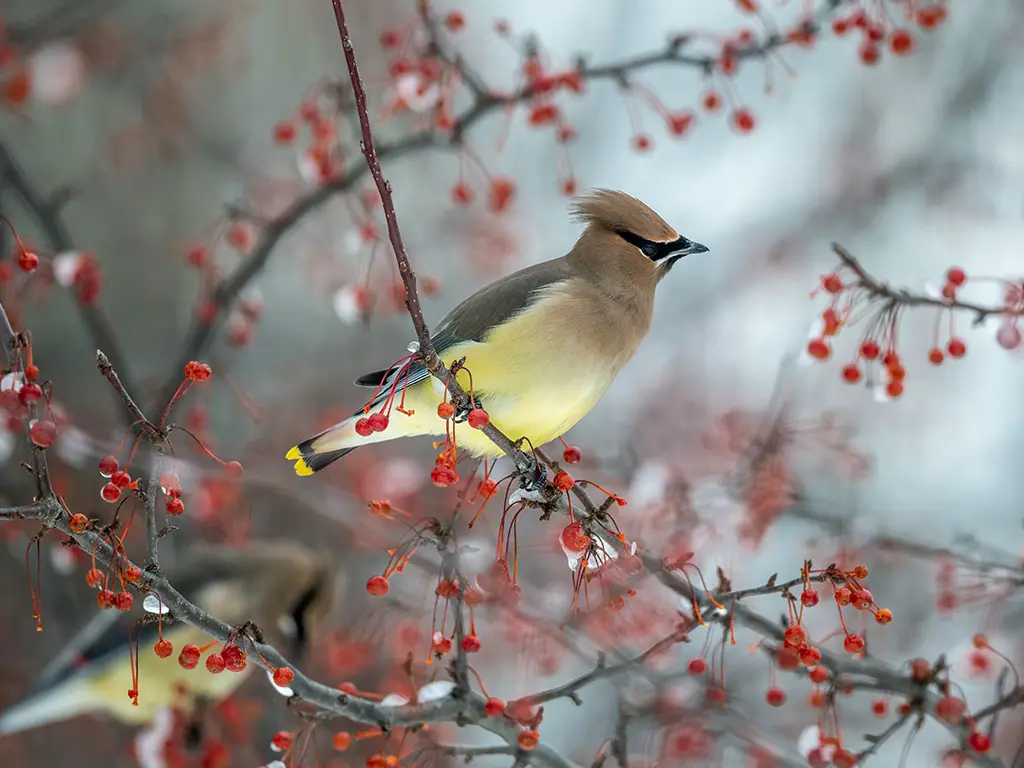Yellow birds are a common and captivating sight in the picturesque state of Washington. These vibrant avian creatures, with their bright yellow plumage and cheerful songs, add a dazzling splash of color to the region’s diverse landscapes.
While several species of yellow birds can be found in Washington, some of the most commonly observed ones include the American Goldfinch, Wilson’s Warbler, and Western Tanager.
From lush forests to urban parks, these feathered wonders can be spotted in a variety of habitats throughout the state, making them a beloved and cherished part of Washington’s natural beauty.
In this article, we will delve into the fascinating world of yellow birds in Washington, exploring their characteristics, habitats, behaviors, and the significance they hold within the state’s ecological tapestry.
1. American Goldfinch

The American goldfinch is a type of bird that is found in North America.
It belongs to the finch family, which is a group of small birds known for their colorful feathers and pleasant songs. This bird is migratory, meaning it travels from one place to another depending on the time of year.
During the breeding season, which is when they mate and lay eggs, the American goldfinch can be found in an area ranging from mid-Alberta in Canada to North Carolina in the United States. In the winter, when the weather gets colder, the American goldfinch migrates to a different region.
They move from just south of the Canada–United States border and travel down to Mexico.
This helps them find better conditions for survival, as the temperature and food availability change with the seasons. The reason for their migration is mainly related to the availability of food.
During the breeding season, the American goldfinch feeds on insects and seeds from plants like sunflowers and thistles.
These food sources are abundant in the areas where they breed, providing them with the necessary nutrients for reproduction and raising their young. However, during the winter, these insects and plants may not be readily available in their breeding grounds.
| Kingdom | Animalia |
| Phylum | Chordata |
| Clade | Dinosauria |
| Class | Aves |
| Order | Passeriformes |
| Family | Fringillidae |
| Genus | Spinus |
| Species | S. tristis |
2. Yellow-Rumped Warbler

The yellow-rumped warbler is a type of bird that is found in North America. It is quite common and can be seen in many different places across the continent. This bird species is known for its distinct yellow feathers on its rump, or lower back.
This is where it gets its name from. These yellow feathers make it easy to identify the yellow-rumped warbler in the wild. The yellow-rumped warbler is a small bird, measuring around 5 to 6 inches in length. It has a slim body with a pointed beak and long wings.
Its wingspan can reach up to 9 to 10 inches, allowing it to fly swiftly and gracefully. One interesting fact about this bird is that it is known for its ability to migrate long distances. During the breeding season, yellow-rumped warblers can be found in North America.
However, when winter arrives, they migrate south to warmer regions, such as Mexico and Central America. This bird species can be found in a variety of habitats. It is often seen in forests, woodlands, and even urban areas.
It has adapted well to different environments and can thrive in both deciduous and coniferous forests. The yellow-rumped warbler has a diverse.
| Kingdom | Animalia |
| Phylum | Chordata |
| Clade | Dinosauria |
| Class | Aves |
| Order | Passeriformes |
| Family | Parulidae |
| Genus | Setophaga |
| Species | S. coronata |
3. Western Tanager

The western tanager is a type of bird that is found in America. It is not very big, but also not too small. In the past, it was thought to belong to the tanager family.
However, now it is classified with other birds in the cardinal family. When we talk about its appearance, the western tanager has certain features that are similar to other birds in the cardinal family.
This includes its feathers or plumage, which have a resemblance to the feathers of other cardinal family members.
Additionally, the way it makes sounds or vocalizes is also similar to other birds in the cardinal family. So, to summarize, the western tanager is an American songbird that used to be considered part of the tanager family but is now classified in the cardinal family.
Its physical appearance and the way it communicates through vocalizations are similar to other birds in the cardinal family.
| Kingdom | Animalia |
| Phylum | Chordata |
| Clade | Dinosauria |
| Class | Aves |
| Order | Passeriformes |
| Family | Cardinalidae |
| Genus | Piranga |
| Species | P. ludoviciana |
4. Common Yellowthroat

The common yellowthroat, a small bird, is commonly found in North America. It belongs to the New World warbler family. This bird is also known by other names such as the yellow bandit or Maryland yellow-throat.
The common yellowthroat is quite prevalent and can be found in large numbers throughout North America. It is a species that breeds extensively in this region. Its breeding range stretches from the southern parts of Canada to the central regions of Mexico.
The yellow bandit is known for its distinctive appearance, with its vibrant yellow throat and breast. This coloring is what gives the bird its common name.
However, it is important to note that both male and female yellowthroats exhibit this yellow coloration, although the males tend to have a more pronounced and vibrant hue. These birds have a small size, typically measuring around 4.7 to 5.1 inches in length.
They have round bodies with short tails and a relatively long bill. The common yellowthroat also features a distinctive black mask that extends from its eyes across its face, which further adds to its unique appearance.
In terms of behavior, the common yellowthroat is known for its agility and quick movements. It is quite active and often observed flitting.
| Kingdom | Animalia |
| Phylum | Chordata |
| Clade | Dinosauria |
| Class | Aves |
| Order | Passeriformes |
| Family | Parulidae |
| Genus | Geothlypis |
| Species | G. trichas |
5. Evening Grosbeak

The evening grosbeak is a type of bird that belongs to the finch family and is found in North America. It is known for its bulky body, large bill, and short tail. Scientists have classified it under the genus Hesperiphona.
| Kingdom | Animalia |
| Phylum | Chordata |
| Clade | Dinosauria |
| Class | Aves |
| Order | Passeriformes |
| Family | Fringillidae |
| Genus | Hesperiphona |
| Species | H. vespertina |
6. Western Meadowlark

The western meadowlark is a type of bird that belongs to the icterid family. It is considered to be medium in size, measuring about 8.5 inches in length. This bird is commonly found in the western and central regions of North America.
One interesting characteristic of the western meadowlark is its nesting behavior. Unlike many other birds, it builds its nest on the ground instead of in trees or bushes. This nesting preference is particularly common in open grassland areas.
In terms of diet, the western meadowlark primarily feeds on bugs. It has a preference for insects, which make up a significant portion of its diet. However, this bird is not solely dependent on bugs for sustenance.
It also consumes seeds and berries, making its diet relatively diverse. The western meadowlark’s choice of habitat and nesting location is closely tied to its diet. By living in open grasslands, it has easy access to the bugs it relies on for food.
Additionally, this habitat provides an ample supply of seeds and berries, which serve as alternative food sources for the bird. Overall, the western meadowlark is an interesting bird species that can be found across western and central North America.
| Kingdom | Animalia |
| Phylum | Chordata |
| Clade | Dinosauria |
| Class | Aves |
| Order | Passeriformes |
| Family | Icteridae |
| Genus | Sturnella |
| Species | S. neglecta |
7. Cedar Waxwing

The cedar waxwing is a type of bird that belongs to the waxwing family of passerine birds, known as Bombycillidae. Passerine birds are perching birds, which means they have feet adapted for gripping branches.
The cedar waxwing is a medium-sized bird with a distinctive appearance. Its feathers are mostly brown, gray, and yellow.
These colors help the bird blend well with its surroundings, making it harder for predators to spot it. One of the most unique features of the cedar waxwing is its wings. The bird gets its name from the wax-like tips on its wings.
These wing tips look as if they have been dipped in wax, giving the bird a fascinating and memorable look. The wax-like wing tips serve a purpose for the cedar waxwing. They are specialized feathers that help the bird in various ways.
The waxy substance on the wing tips repels water, allowing the bird to fly more easily in wet weather conditions. It also helps the bird glide smoothly through the air, reducing air resistance. Another interesting aspect of the cedar waxwing is its diet.
This bird primarily feeds on fruits, such as berries, and small fruits like cherries. It has a unique adaptation in it.
| Kingdom | Animalia |
| Phylum | Chordata |
| Clade | Dinosauria |
| Class | Aves |
| Order | Passeriformes |
| Family | Bombycillidae |
| Genus | Bombycilla |
| Species | B. cedrorum |
8. Northern Flicker

The northern flicker is a type of bird that belongs to the woodpecker family. It is not a very large bird, but it is also not too small. The northern flicker can be found in many parts of North America.
It is also native to some areas in Central America, such as Cuba and the Cayman Islands. One interesting thing about the northern flicker is that it is one of the few woodpecker species that migrate.
Migration means that these birds travel from one place to another during different seasons. They do this to find food and suitable habitats.
The northern flicker migrates to different regions depending on the time of year. During the breeding season, which is usually in the spring or summer, the northern flicker can be found in many parts of North America.
They build their nests in trees and use their strong beaks to create holes in the wood. These holes are called cavities and serve as their homes. Northern flickers are known for their distinctive markings.
They have a brown body with black spots, and their wings have a white patch that is easily visible when they fly. Another unique feature is the red or yellow coloration on the underside of their wings and tail, which can be seen when they.
| Kingdom | Animalia |
| Phylum | Chordata |
| Clade | Dinosauria |
| Class | Aves |
| Order | Piciformes |
| Family | Picidae |
| Genus | Colaptes |
| Species | C. auratus |
Conclusion
Yellow birds in Washington represent a diverse and vibrant part of the state’s avian population. They are highly visible and easily identifiable due to their bright yellow plumage.
These birds, such as the American goldfinch and the western tanager, bring a splash of color to the local forests, meadows, and backyards.
The presence of yellow birds not only adds aesthetic appeal to the environment but also contributes to the overall biodiversity of the region.
It is important to appreciate and protect these beautiful creatures and their habitats to ensure their continued presence in Washington’s natural landscapes.